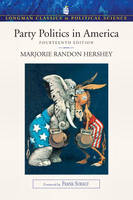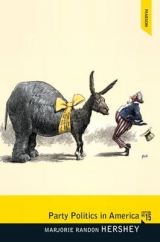
Party Politics in America (Longman Classics in Political Science)
Routledge (Verlag)
978-0-205-79319-8 (ISBN)
- Titel erscheint in neuer Auflage
- Artikel merken
It covers the historic 2008 Presidential campaign and election while looking ahead to assess what the shifting political winds have in store for the future of the major political parties and Americans’ political views.
Foreword by John H. Aldrich
Preface
Part 1: Parties and Party Systems
Chapter 1: What Are Political Parties?
The Three Parts of Parties
The Party Organization
The Party in Government
The Party in the Electorate
What Parties Do
Electing Candidates
Educating (or Propagandizing) Citizens
Governing
The Effects of Party Activity
How Do Parties Differ from Other Political Groups?
Parties Are Paramount in Elections
They Have a Full-time Commitment to Political Activity
They Mobilize Large Numbers
They Endure
They Serve as Political Symbols
How the American Parties Developed
The Founding of American Parties
A National Two-Party System Emerges
The Golden Age of the Parties
The Progressive Reforms and Beyond
What Do the Parties Stand For?
Parties Are Shaped by Their Environment
Voters and Elections
Political Institutions
Laws Governing Parties
Political Culture
The Broader Environment
Chapter 2: The American Two-Party System
The National Party System
The 50 State Party Systems
Measuring State Party Competition
Limits on Competitiveness: Incumbency
…And Other Reasons for Declining Competitiveness
What Causes a Two-Party System?
Institutional Forces
"Dualist” Theories
Social Consensus Theories
Party Self-Protection (The Best Defense Is a Good Offense)
Exceptions to the Two-Party Pattern
Nonpartisan Elections
Areas of One-Party Monopoly
Third Parties
Differences in Ideology
Difference of Origins
Differing Purposes
What Difference Do They Make?
The Rise of Independent Candidates
Will the Two-Party System Continue?
Part 2: The Political Party as an Organization
Chapter 3: The State and Local Party Organizations
What Is a “Strong” Party?
State Regulation of the Parties
Levels of Party Organization
Local Party Committees
State Central Committees
The Legendary Party Machines
How the Party Machines Developed
How Machines Held on to Power
Local Party Organizations Declined and Then Rebuilt
Local Parties in the 1970s
Local Parties Today: Richer and More Active
The State Parties: Gaining Money and Services
Traditional Weakness
Increasing Strength in Recent Years
Fund-raising
Campaign Services
Republican Advantage
Allied Groups
The Special Case of the South
National Party Money
Summing Up: How the State and Local Party Organizations Have Transformed
Chapter 4: The Parties’ National Organizations
The National Parties
The National Committees
National Party Chairs
Presidents and Their National Parties
Other National Party Groups
Congressional Campaign (“Hill”) Committees
Women’s and Youth Groups
Democratic and Republican Governors’ Associations
Two Paths to Power
The Service Party Path
The Democrats’ Procedural-Reform Path
Both Parties Take the Service Path
Rising to the Challenge of New Campaign Finance Rules
Party Money and Activism in the 2008 Elections
What Is the Impact of These Stronger National Parties?
Effects on Candidates’ Campaigns
Effects on State and Local Parties
The Dean 50-State Strategy
Effects on the Presidency
Effects on Congress
Relationships within the National Party
The Limits of Party Organization
Chapter 5: Party Activists
What Draws People into Party Activity?
Material Incentives
Patronage
Elected Office
Preferments
Solidary (Social) Incentives
Purposive (Issue-Based) Incentives
Mixed Incentives
Professional and Amateurs
How Do Parties Recruit Activists?
Finding Volunteers: Is Anybody Home?
Means, Motive, and Opportunity
What Kinds of People Become Party Activists
People from “Political Families”
Better Educated and Wealthier Than Average
Different Agendas
More Extreme Views
Party Activists and Democracy
The Problem of Representation
Amateurs and Pressure for Internal Party Democracy
Activists, Party Strength, and Democracy
Part 3: The Political Party in the Electorate
Chapter 6: Party Identification
How People Develop Party Identifications
Childhood Influences
Influences in Adulthood
Patterns of Partisanship over Time
Has There Been a Decline in Partisanship?
The Recent Rise in Democratic Party ID
Party Identification and Political Views
Party Identification and Voting
Party Voting
Party Versus Candidates and Issues
Partisanship as a Two-Way Street
Party Identification and Political Activity
Party Identification and Attitudes toward the Parties
The Myth of the Independent
Attitudinal Independents
Behavioral Independents
Are Independents a Likely Source of Support for Third-Party Candidates?
Change in the Impact of Party ID
A More Candidate-Centered Politics
The Continuing Significance of Party
Chapter 7: Party Coalitions and Party Change
The American Party Systems
The First Party System
The Second Party System
The Third Party System
The Fourth Party System
The Fifth Party System
The Social Bases of Party Coalitions
Socioeconomic Status Divisions
Sectional (Regional) Divisions
Age
Religion and Religiosity
Race
Ethnicity
Gender
The Central Role of Issues in the Group-Party Linkage
Polarization of the Polarization of the Two Parties’ Coalitions on Issues
The Development of the Sixth Party System
Major Changes in the Parties’ Supporting Coalitions
From Democratic Majority to Close Competition
How Can We Characterize These Changes: Realignment, Dealignment, or What?
Problems with the Idea of Realignment
Chapter 8: Parties and Voter Turnout
Elections: The Rules Affect the Results
Expansion of the Right to Vote
Rules Affecting Access to Voting Rights
The Secret Ballot
Citizenship
Residence
Residence Registration
The Special Case of Voting Rights for Black Americans
The Long Struggle for Voting Rights
From Voting Rights to Representation
Getting Blacks’ Votes Counted
Efforts to Liberalize Voting Rules
Election Day Registration
"Motor Voter” Laws
Early and No-Excuse Absentee Voting
The Voter ID Controversy
Voter ID Laws
Proof of Citizenship
Voting Systems: Are Votes Counted Fairly?
The Low Turnout in American Elections
Why Don’t More Americans Vote?
Individual Differences in Turnout
Education
Youth
Gender and Race
Social Connectedness
Political Attitudes
The Impact of the Current Campaign
The Excitement of the Election
Close Competition
Party Efforts to Mobilize Voters
Do Party Efforts Diversify the Electorate?
The Challenge to the Parties
Part 4: Parties, Nominations, and Elections
Chapter 9: How Parties Choose Candidates
How the Nomination Process Evolved
Nominations by Caucus
Nominations by Convention
Nominations by Direct Primaries
The Current Mix of Primaries and Conventions
Types of Primaries
Closed Primaries
Open Primaries
Blanket Primaries
Why Does the Type of Primary Matter?
How Candidates Qualify
How Do Candidates Get on the Ballot?
Runoffs: When Too Many Candidates Get on the Ballot
What Parties Don’t Like About Primaries
Difficulties in Recruiting Candidates
The Risk of Unattractive Nominees
Divisive Primaries
Problems in Holding Candidates Accountable
The Party Organization Fights Back
Persuading Candidates to Run (or Not to Run)
Endorsing Candidates
Providing Tangible Support
Candidates and Voters in the Primaries
Many Candidates Run Without Competition
...And Voters Are in Short Supply
The Impact of the Direct Primary
Has It Made Elections More Democratic?
How Badly Has It Harmed the Parties?
Is the Primary Worth the Cost?
Chapter 10: Choosing the Presidential Nominees
The Move to Presidential Primaries
Turbulence in the Democratic Party
Presidential Primaries and Caucuses Today
The Race to Win Delegate Votes
The “Invisible Primary”
Candidates’ Strategic Choices
Win Early or Die
Comparing the Clinton and Obama Strategies
What Is the Party’s Role?
Voters’ Choices in Presidential Nominations
Who Votes?
Are Primary Voters Typical?
Do Voters Make Informed Choices?
Do Primaries Produce Good Candidates?
On to the National Conventions
Roots of the Conventions
What Conventions Do
Approving the Platform
Formalizing the Presidential Nomination
Approving the Vice-Presidential Nominee
Launching the Presidential Campaign
Who Are the Delegates?
Apportioning Delegates among the States
How Representative Are the Delegates?
Demographics
Political Experience
Issues
Amateurs or Professionals?
Who Controls the Delegates?
How Media Cover Conventions
Do Conventions Still Have a Purpose?
Should We Reform the Reforms?
What Could Be Done?
Chapter 11: The General Election
Campaign Strategy
How Campaigning Has Changed
Professional Consultants
Sources of Information
Computers
Polls
Methods of Persuasion: the Air War
Television
The Internet
Social Networking Sites
E-mail
The Ground War: “Under the Radar”
Direct Contact by Mail, Text, and Twitter
Direct Mail
Text Messaging
Twitter
Canvassing and Phone Banks
MicrotMicrotargeting
Negative Campaigning
The 2004 Campaign
Democrats Regain the Advantage in 2006
The Old and the New in 2008
Do Campaigns Make a Difference?
The Argument That Campaigns Matter
The Argument That They Don’t
Some Tentative Answers
Candidate-Centered or Party-Centered Campaigns?
Party Influence in Competitive Campaigns
The Continuing Struggle between Candidates and Party Organizations
Chapter 12: Financing the Campaigns
How Much Money Is Spent on Campaigns?
Presidential Campaigns
Congressional Campaigns
State and Local Campaigns
What Is the Impact of Campaign Spending?
Where Does the Money Come From?
Individual Contributors
Political Action Committees
Parties
The Candidates Themselves
Public Funding
Money in State and Local Campaigns
Reform of the Campaign Finance Rules
Contribution Limits
Public Disclosure
Public Funding of Presidential Campaigns
Spending Limits
The Loopholes That Ate the Reforms
Independent Spending
Soft Money
Issue Advocacy Ads
527 and 501(c) Advocacy Groups
What Did the 1970s Reforms Accomplish?
Intended and Unintended Effects
Effects on the Parties
Another Try: The Bipartisan Campaign Reform Act (BCRA)
Big and Small Contributions in 2004 and 2008
The Parties Survived BCRA
State Regulation and Financing
Money in American Politics
Part 5: The Party in Government
Chapter 13: Parties in Congress and State Legislatures
How the Parties Are Organized in Congress
Changes in the Power of House Party Leaders
The Revolt Against “Czar” Cannon
Growing Party Coordination
The Gingrich Revolution
… And the Change to Democratic Control
What Caused This Stronger Party Leadership?
Parties in the “Individualist Senate”
Parties in the State Legislatures
Methods of Party Influence
Carrots and Sticks
Agenda Control
Party Influence on Legislative Voting
How Unified Is Each Legislative Party?
Party Votes
Party Support
Greater Polarization of the Congressional Parties
When Are the Parties Most Unified?
Issues That Touch the Interests of the Legislative Parties
The Executive’s Proposals
Policies Central to the Party System
Comparing Party Power in Congress and State Legislatures
Party Polarization and Cohesion
Greater Interparty Competition
No Competing Centers of Power
Other Needed Resources
Lesser Legislative Professionalism
Styles of Individual Leaders
The Power of Legislative Parties
Chapter 14: The Party in the Executive and the Courts
Presidents and Governors as Party Leaders
The President as Campaigner-in-Chief
The President as the “Top of the Ticket”
Coattail Effects
Coattails Even without the Coat
Party Leadership and Legislative Relations
Legislative Support for Executives
Divided Control of Government
Party Influence in Executive Agencies
Limits on Presidential Influence: Bureaucrats Have Constituents Too
Party Experience Among Bureaucrats
Changing Political Outlooks in the Federal Bureaucracy
Traces of Party in the Courts
Judicial Voting Along Party Lines
What Causes Partisan Behavior on the Courts?
Party and Judicial Appointments
Federal Judges
State Court Judges
The Party within the Executive and the Judge
Chapter 15: The Semi-Responsible Parties
The Case for Responsible Party Government
How Would Party Government (Responsible Parties) Work?
The Case Against Party Government
It Would Increase Conflict
It Wouldn’t Work in American Politics
The Gingrich Experiment: A Temporarily Responsible Party
Party Cohesion and Ideology
Are the American Parties Ideological?
Do They at Least Offer Clear Choices?
But Internal Divisions Remain
Ideology and the American Voter
How Ideological Is the American Public?
Differences among Voters, Activists, and Candidates
When Is Party Government Most Likely?
When There Is Strong Presidential Leadership
In Times of Crisis
When the Parties’ Supporting Coalitions Realign
Party Government and Popular Control
Chapter 16: The Place of Parties in American Politics
Parties and Their Environment
The Nature of the Electorate
Political Institutions and Rules
Societal Forces
Party Decline in the 1960s and 1970s
The Parties in the Electorate
Party Organizations
The Party in Government
Shifting Power Centers within the Parties
Party Renewal
Change in the Parties’ Electoral Coalitions
A Return to Democratic Party Dominance?
The Rise of More Cohesive Parties in Government
The New “Service” Parties
The Future of Party Politics in America
A Changing Intermediary Role
The Need for Strong Parties
How to Make the Parties Stronger
Conclusion: The Parties’ Prospects
Party Politics on the Internet
Appendix
Endnotes
Index
| Erscheint lt. Verlag | 25.3.2010 |
|---|---|
| Verlagsort | New York |
| Sprache | englisch |
| Maße | 152 x 229 mm |
| Gewicht | 513 g |
| Themenwelt | Sozialwissenschaften ► Politik / Verwaltung ► Politische Theorie |
| ISBN-10 | 0-205-79319-3 / 0205793193 |
| ISBN-13 | 978-0-205-79319-8 / 9780205793198 |
| Zustand | Neuware |
| Haben Sie eine Frage zum Produkt? |
aus dem Bereich



